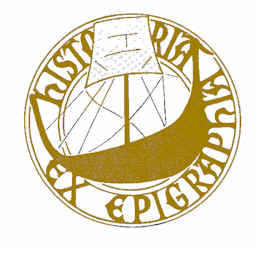
The Epigraphic Society

|
The Epigraphic Society
|
|
|
COMMENTS ON AN IBERIC INSCRIPTION FROM BARCELONA, SPAIN Donal Buchanan (from his Iberic Database, a work in progress)
Below is a sepulchral inscription from Barcelona, Spain. It is in an Iberic script: Inscription:
Transliteration: NoViCIa LaTRA CaVa eI Cognate Lang: Novicia Latra, cava ei Translation: Novicia Latra, her grave (lit.: a [burial] cavity or cave for her). The first thing to remember about this and all other inscriptions from Iberia that appear to be in a form of Latin is that we are not dealing here with pure classical Latin, but with a dialectical version possibly peculiar to Spain that may reflect forms intermediate between classical Latin and/or Vulgar (Common) Latin and Spanish. The dialect may be rather like Lepontic, Umbrian, Oscan or Venetic in Italy. Also, these inscriptions are not only from widely separated sites, they are also widely separated in time (and sometimes are in scripts that show peculiarities specific to certain areas). These inscriptions as a group could be as early as 200 BC and as late as 200 AD. This particular inscription, in my opinion, may date to between 25 BC and sometime early in the first century AD. Three lines are combined as one here (see the graphic). The first word, NVCI, is alone on the top line of the inscription and is a female personal name derived from the Latin novicius -a -um (adj.) = new, fresh (C397A; LS1219B). The form here is the feminine nominative singular Novicia (it could be read as the genitive sg. Novici, but that is hardly likely since it should agree with the following surname which is in the feminine nominative singular). The second word, LTRA, which is alone on a second line, is probably a feminine form of a Roman surname, Latro -onis (m.n.), known to exist in Spain in the time of Seneca (54 BC-39 AD) (LS1041A). The surname, Latro, probably derives from the Latin latro -onis (n.m.) = a servant, a hireling, a mercenary, a soldier; a robber, a freebooter, a pirate (C338B; LS1041A) and is cognate with the Spanish ladron -na (m.& f. n.) = a thief, a robber, a highwayman (V402A) and Italian ladro (n.m.) = a thief, robber (CI285A). While the Latin surname is demonstrably masculine, the fact that its derivative in Spanish, ladron, now has both a masculine and feminine form argues that by this time in Spain the surname Latro could have been written with a feminine ending as Latra (in this case to agree in gender with the feminine name Novicia). There are two possibilities for the third word, CV, which begins the third line of this inscription. It could be a form of the Latin cavea (cava) -æ (f.n.) (genitive caveai or cavæ or cavai) = an excavated place, a hollow, a cavity (a cave); an enclosure for animals, a stall, a cage, a coop, a den, a beehive (C96A; LS305B; Ox286C,287A). It also could be a form of the Latin verb caveo, cavi, cautum = to be on one’s guard, take care, take heed, beware; guard against, be aware of; to take care for, provide; to protect, have a care for, attend to a thing for a person (C96B; LS305Bff; Ox287B). Where I had previously read CV as a verb, I now lean to the noun—see the first definition given above: a cave, in the sense of a burial cavity or grave. The single character, I (Y or Ya or Yo or Ye or E or Ea), ends the third line of this inscription. It is clearly separated from the preceding word (see the graphic of the inscription) and thus must be considered to be a word on its own, probably a pronoun. It probably should represent a dative form of the pronoun ei = to/for her, him or it (W49). It could also represent a nominative form, ea (pronounced Ya) = she (W49), but that would make little sense here. So, we have: Novicia Latra (a given name and surname in the nom. sg.) cava ei (cava is nom. sg. and it is followed by a pronoun that would appear to be dative 3rd. sg.) = Novicia Latra, her grave (lit. a [burial] cavity or cave for her). My first version of this inscription (published in ESOP, Vol 13, 1985) ("Novicia Latra, Care for her!") was recently ridiculed by a colleague well-known for his caustic criticisms (LMN7, Jan 94). He was correct, of course, to point out the weaknesses in the decipherment; but incorrect in his method of doing so. Ridicule, while amusing, is unscholarly and unacceptable as a form of criticism. Constructive criticism and suggested changes are always acceptable. One positive result: I am taking another look at earlier decipherments—including this one—with an eye to bettering them. Having been involved in epigraphy for over three decades, I realize that it is necessary to continue to learn and to revise earlier work when appropriate. C = Cassel’s Latin Dictionary by D.P. Simpson, Macmillan, NY, 1977. CI = Cassell’s Italian Dictionary by Piero Rebora et al, Macmillan, NY, 1978. LMN = Louisiana Mounds Newsletter, Shreveport,LA & Houston, TX, 1994. LS = A Latin Dictionary by C.T. Lewis & Charles Short; Clarendon Press, Oxford, England, UK, 1980. Ox = Oxford Latin Dictionary by P.G.W. Glare; Clarendon Press, Oxford, England, UK, 1983. V = A New Pronouncing Dictionary of the Spanish and English Languages by M. Velazquez de Cadena; Prentice Hall, NJ, 1973. W = Latin, An Introductory Course by F.M. Wheelock, Barnes & Noble, NY, 1963. |
Send mail to donalbb@epigraphy.org
with
questions or comments about this web site.
|